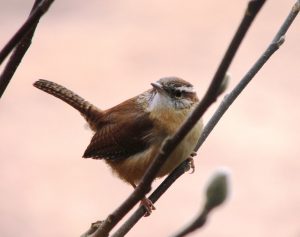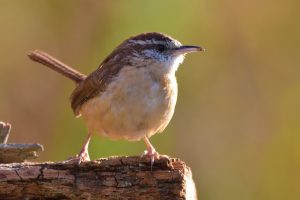The wren is a hard-working little bird that happily co-exists alongside humans even though they are very shy by nature. Instantly recognisable by their incredibly loud and tuneful song, pound-for-pound the wren is 10 times louder than a nightingale!
When the song of the male becomes more prolific and noticeable it is a sign that he is looking for a mate. If that is happening in your garden then you’re already halfway to knowing where wrens make their nests. He has chosen the area that includes your garden as his territory and is trying to attract a mate.

Wrens live year-round in the UK and are found in most urban and suburban sites. Farmland, woodland, and heath are often rife with wrens but they also happily make their home in back gardens and are happy utilising your nesting boxes.
They are secondary cavity nesters which means they don’t excavate their own nest but utilise naturally occurring hollows. They will also happily use nests vacated by other birds and are known to bully blue tits from their nests, break their eggs, and move into their space.
Table of Contents
Does the female or male wren build the nest
Males find an appropriate nesting site and begin the nest building process using tiny twigs. But he doesn’t stop there, he will continue to build as many as 12 nests and invite his chosen mate to choose her favourite. If she likes one they will become a couple and she will complete the nest with twigs.
What wrens line their nests with
Once the exterior is complete she sets about lining the interior with soft materials such as feathers, grasses, and moss. Cleverly, she makes a small indentation at the rear of the nest in which to lay the eggs. She lays between 5-8 eggs so the more room the better.
Spiders everywhere
It is not uncommon to find sacs of spider larvae in the construction of wrens nests. This is ingenious work by the wren for 3 reasons;
- The sticky sac acts as a bonding agent
- The hatching spiders eat the nuisance mites that form as the nest deteriorates
- Fattened spiders are a juicy treat for wrens
Where do wrens build their nests
Wrens in the wild will happily nest as high as 30ft and as low as 5ft. Due to the nature of gardens, they make their home in trees, shrubs, and bushes between 5 and 10 feet from the ground. Usually, but there are always exceptions to the rule, wrens might nest in the eaves of a roof or a window box.
They are insectivorous birds although berries and nuts will appeal to them when winter settles and insects are harder to find. They will build their nests near to a good food source, close to berry bushes and piles of fallen leaves where inset life will be plentiful.

They also look for areas with fresh, clean water sources. Moving water is particularly inviting so if you have a water feature, wrens might be tempted to build their nest in your garden.
Do the other nests go to waste?
Think back to me saying that wrens make up to 12 nests for the female to choose from. Any not used by the couple may well be used by a second female, sometimes a third. Wrens are polygamous, and whilst he will spend most of his time with the original mate, he will devote some time to other mates.
During harsh winters, large groups of wrens may seek shelter from the elements and roost in the unused nests. As many as 40 birds can snuggle tightly in each nest to absorb each other’s limited body heat.
Final thoughts…
Now that you know where wrens build their nests it should be easier to follow the little fellas in flight to see if they’ve chosen your garden to raise their family.

T hank you this was very interesting we have a little wren comes around our garden, don’t think his nest is in it but we have lots of trees around, don’t want to put food out because there is a few cats come around. Did enjoy his singing and now know why he does it thanks again😀
we have a little wren comming backwards and forwards to a nesting box in our garden, we dont see him every day though so i dont know what its up too, i watch it bringing twigs and other bits and pieces to the nest box. it seem to keep away from the other little birds that come in our garden and use the feeding table. i do hope it nests and it lays eggs fingers crossed.